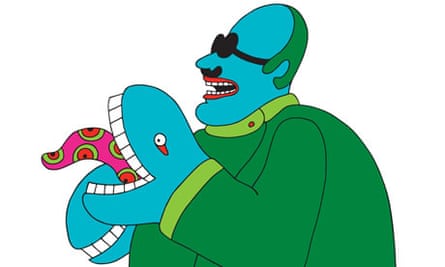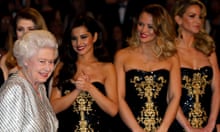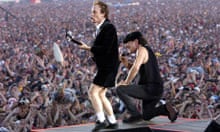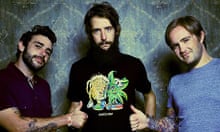Going to see Yellow Submarine is my first memory ever. And it's a doozy. A world-shaking, world-shaping event. It was the early 1970s and I was taken to see the movie on a big screen. It blew my young, impressionable six-year-old mind and I'm pretty sure it's what sent me on a career path in animation. I'm just glad my parents took me to see that and not A Clockwork Orange.
There have been some excellent books about the making of the film (I highly recommend Inside the Yellow Submarine by Dr Robert Hieronimus), so rather than blab on about the back story, I would rather talk about what happened after the yellow sub surfaced in 1968 and shot its torpedoes through traditional animation. Because in my opinion, Yellow Submarine gave birth to modern animation itself.
Before Yellow Submarine, animation was a mild, goody-goody world of personality-free gloved mice and cartoon bears stealing picnic baskets. Only the Fleischer brothers in the 1930s dared to do really weird stuff with their early Popeye cartoons, and most of that is unknown to the general public. But after Yellow Submarine, it was a wholly different world. It wasn't just for kids. It was satire and art and, most of all, subversion.
Without Yellow Submarine there would never have been The Simpsons, no Futurama, no South Park, no Toy Story, no Shrek. No animated anything that enables us to laugh at ourselves while being highly entertained.
A couple of specific references from The Simpsons. Remember in the chilli episode, where Homer eats the "insanity pepper" and goes on a trip? As it begins, Homer is seen floating against live-action clouds. After the table-read of the script, I told the director: "Make it like that George-on-the-mountain-top scene in Yellow Submarine. You know that one?" And of course he knew, because he was of a generation that grew up loving that movie.
Another example is in an episode of The Simpsons called Last Exit to Springfield. Lisa needs braces and the orthodontist gives her gas, whereupon she goes into a psychedelic trip – Lisa in the sky (without diamonds) – that is a brilliant parody of Yellow Submarine. I counted about 20 specific references.
That lightness, that quickness, that unembarrassed, unencumbered willingness to be goofy – that's all very Beatlesque. Sure, there are other influences (and the Beatles themselves loved stuff like The Goon Show and Edward Lear), but I think the Beatles' impact on modern comedy is sorely unappreciated.
I can't talk about the comedy in Yellow Submarine without giving a nod to someone who wasn't given a nod in the movie, but by all accounts was largely responsible for much of the humour: Liverpool poet Roger McGough, also a favourite of the Beatles. At some point during production, he was called in to do a pass on the script and make the dialogue more Liverpudlian and authentic; and, by many accounts, it was he who added so many great jokes and Beatles-style wordplay.
Let me talk about the words. There never was a complete script, and much of it was apparently written on the fly – one of the reasons the movie has such a stream-of-consciousness, dream-like appeal, and an important lesson to more anal writers like myself. Words aren't just spoken: they appear on screen. Often. Like in the incredible When I'm Sixty-Four sequence of animated sentences and numbers. Or all the times LOVE, KNOW, OK and other words appear as monuments in Pepperland. The artists who made Yellow Submarine celebrated words and numbers as art. They weren't the first to do so, but their work influenced generations of graphic designers.
The film is a 90-minute work of art. Led by brilliant, visionary designer Heinz Edelmann and director George Dunning, a team of mostly young, unsung artists toiled away in rinky-dink offices in Soho Square, London, for nearly a year, with a budget of less than $1m. There are sequences like Eleanor Rigby (where, by the way, you can actually see some of these unsung artists) and Lucy in the Sky with Diamonds that are pop art masterpieces as good and breathtaking as any Warhol or Picasso.
The artists and directors used techniques no one had ever used before, and haven't since. They used media no one had ever thought of using in animation: the sequence where the sub takes off from the Pier and appears to travel rapidly through all sorts of live-action settings, including a park where a statue of a military man astride a horse appears to tip his hat to you, was all done using postcards. If you freeze-frame it, you can see some of the brilliant tricks they came up with.
So how did all this happen? Well, here I do need to get into a little back-story, because it's an important lesson in how brilliant things get produced. It's how The Simpsons came to be, and it's how Yellow Submarine happened. It's called trusting in artists and letting them do their stuff. It's also called I-have-no-idea-what-those-hippies-in-Soho-are doing-but-it-has-the-Beatles'-name-on-it-so-I-guess-we'll-make-money. From what I've read, the pressure these artists felt came from not wanting to let the Beatles down because they loved them and their music so much. That's a great sort of pressure to be under.
Also, I have a feeling that King Features – the cartoon publisher that made the film – had no idea what it was getting. I think even the Beatles had no idea what they were getting. When production began, the only thing the Beatles knew was that there had been that horrible cartoon from the mid-1960s. You know, that one where they had big heads on little bodies. They hated that cartoon and were wary of this one. Only when they visited the studios and saw what was happening did they start to rally round it (remember, they didn't voice their characters – something I was horrified to find out years later).

Yellow Submarine was made with a small budget. There were numerous instances where they had neither the time nor the money to do something the fancy, easy way, so they were forced to come up with new ways. If you have zillions of dollars and all the time in the world, I don't think you're going to produce great art. And you certainly won't feel like sticking it to the man who's giving you those zillions. It's funny, isn't it? In an ideal world, you wouldn't have the types of pressures that can lead to great art. Yet Yellow Submarine is a movie whose message is all about making an ideal world. And it's one of the most perfect pieces of moving art ever made.
Josh Weinstein is a former producer of The Simpsons. With Bill Oakley, he wrote many classic episodes including Who Shot Mr Burns? and Lisa vs Malibu Stacy. He is currently co-executive producer of Futurama and lead writer for the innovative CBBC series Strange Hill High. Yellow Subversion: The Artwork of Yellow Submarine, a limited edition box set of screenprints, is available from £395.







Comments (…)
Sign in or create your Guardian account to join the discussion